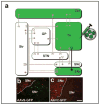Axonal transport of adeno-associated viral vectors is serotype-dependent
- PMID: 22418061
- PMCID: PMC3381869
- DOI: 10.1038/gt.2012.27
Axonal transport of adeno-associated viral vectors is serotype-dependent
Abstract
We have previously shown that adeno-associated virus type 2 (AAV2) undergoes anterograde axonal transport in rat and non-human primate brain. We screened other AAV serotypes for axonal transport and found that AAV6 is transported almost exclusively in a retrograde direction and, in the same way as AAV2, it is also neuron-specific in rat brain. Our findings show that axonal transport of AAV is serotype dependent and this has implications for gene therapy of neurological diseases such as Huntington's disease.
Conflict of interest statement
No competing financial interests exist.
Figures






References
-
- Kaspar BK, Llado J, Sherkat N, Rothstein JD, Gage FH. Retrograde viral delivery of IGF-1 prolongs survival in a mouse ALS model. Science. 2003;301:839–842. - PubMed
-
- Daadi MM, Pivirotto P, Bringas J, Cunningham J, Forsayeth J, Eberling J, et al. Distribution of AAV2-hAADC-transduced cells after 3 years in Parkinsonian monkeys. Neuroreport. 2006;17:201–204. - PubMed
Publication types
MeSH terms
Substances
Grants and funding
LinkOut - more resources
Full Text Sources
Other Literature Sources

